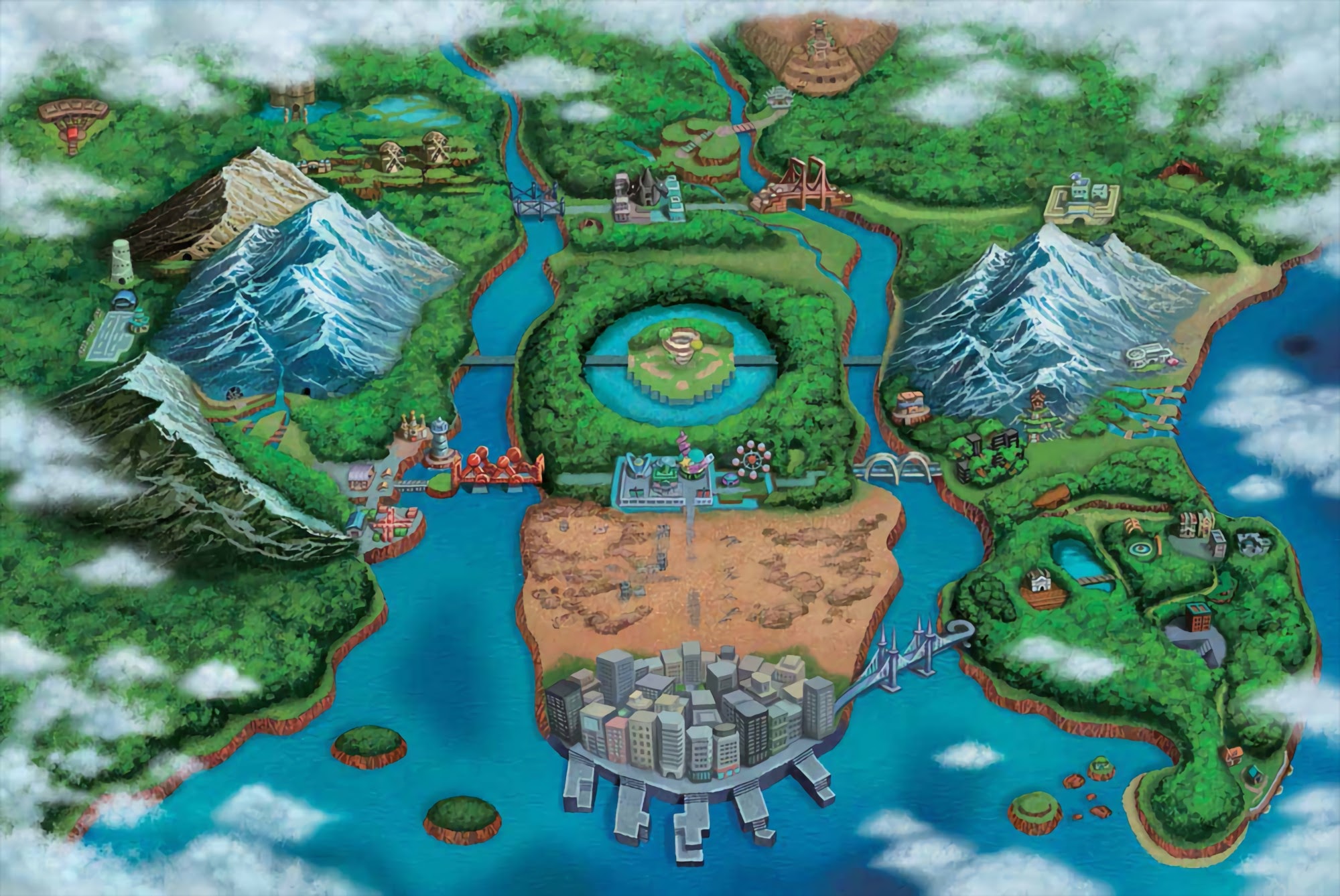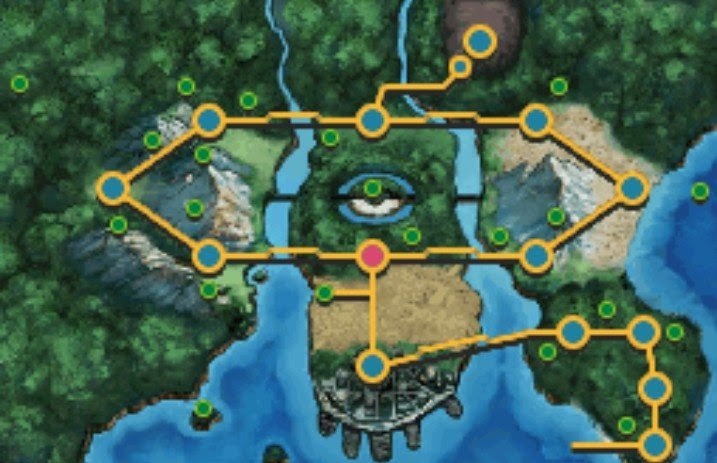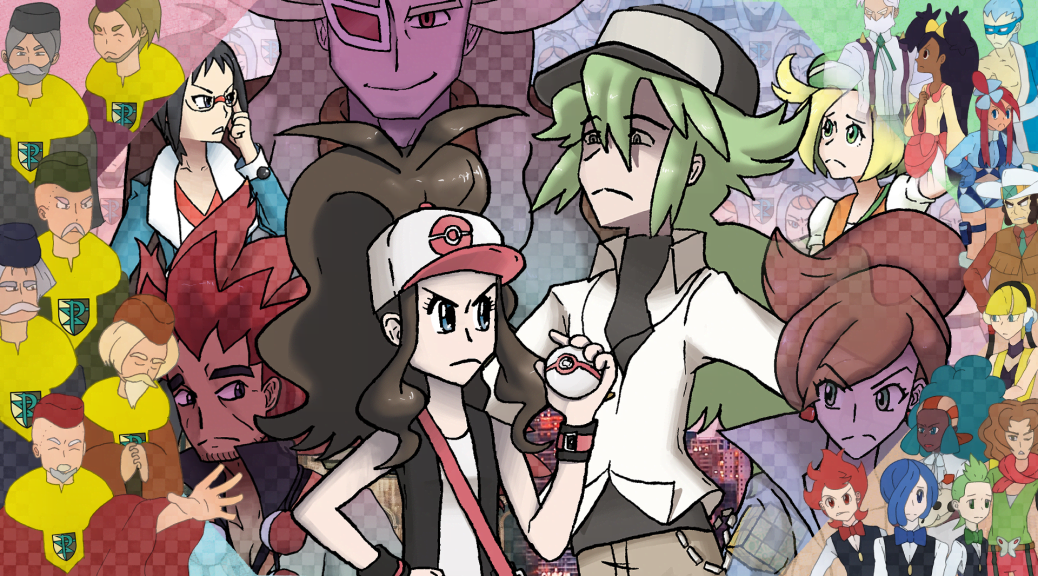Part I: The Components of Unova
For the anniversary of the release of Pokémon Black and White, we release our tribute to the games. Part I focuses on gameplay and other mechanics, as well as their themes.

Part I: The Components of Unova
Hexagons | Adventure | Dreams | Seasons
Discovery | Myths | Sprites | Music | Accessibility
The Shape of Unova: The Perfect Unity of Hexagons
When someone berates the layout of the Unova region because “it’s just a circle,” it takes a lot of self-control to not sassily retort with “No, it’s a hexagon.” The disdain towards linearity is an odd one, as the Pokémon series has historically handled non-linearity very poorly. In Johto, the three Gym Leaders following Morty all have fewer Pokémon than him—Jasmine and Pryce owning three and Chuck with a whopping two—and are all within the same level range to boot. Sure, the player has control over what order they challenge them in, but due to the linear level system, the “challenge” is gone by the second battle.
This also means the average levels in the six routes and three landmarks surrounding Olivine, Mahogany, and Cianwood are all in the same paltry range. That is one-third—or 30% in the remakes—of Johto’s routes and a little over a third of its Gym Leaders in the exact same level range, all for the “trade-off” of the player maybe realizing they can fight Pryce before Chuck. That is the entire trade-off, because really, who is going to leave Chuck—and HM Fly—behind just to fight Jasmine first? If you’re already there, why would you not?
And when non-linearity is forced, it doesn’t improve the game, either. Is there really any benefit to skipping Hearthome Gym the first time around in Diamond and Pearl? Even with access to HM Fly to avoid backtracking through masses of underleveled wild Pokémon, it’s still time wasted that could instead be used to progress towards new, unseen locations. Even the developers recognized this as needless and altered the Gym order in Platinum to ensure the player spends more time moving forward than wasting time falling back.
 All the while your team of Pokémon will progress linearly. The level system that has been a crucial component of the Pokémon series battle formula since its inception is as linear as they come—levels progress ever forward along the number line until they max out at 100. But on top of that, the narrative of Pokémon games pan out linearly as well. Time moves forward linearly, and because Pokémon narratives follow the natural flow of time, it’s safe to assume their stories, too, are linear.
All the while your team of Pokémon will progress linearly. The level system that has been a crucial component of the Pokémon series battle formula since its inception is as linear as they come—levels progress ever forward along the number line until they max out at 100. But on top of that, the narrative of Pokémon games pan out linearly as well. Time moves forward linearly, and because Pokémon narratives follow the natural flow of time, it’s safe to assume their stories, too, are linear.
But does that mean the layout of the region absolutely needs to match the linearity of the narrative? We can see what happens when Pokémon tries to have the best of both worlds in Alola. The beautiful, tropical region is littered with man-made fences gating off the player from exploring any place that isn’t the very next area narratively. And the fences are still not enough to keep the player “on track,” so NPCs and other obstacles crop up to tell you, the player, on your very own journey, exactly where you must go. The result of applying a linear narrative to a non-linear map is roadblocks. Roadblocks, roadblocks, roadblocks—immersion-breaking as the player is directly reminded that they are not allowed to explore this vast world at their leisure. The player is significantly less likely to enjoy a linear progression when it feels forced upon them due to excessive roadblocks pushing them in a certain direction.
The linearity of Unova, on the other hand, allows for a smooth, natural flow of both gameplay and narrative. Because the narrative is directly rooted in the series’s gameplay formula, it is only natural that even the layout of the region reflects this. The Gyms are no longer a glorified side quest, but a necessary component to defeating N, who himself intends to become the Champion to achieve his goals. The player is therefore naturally inclined to challenge the Gym or check out any other major point of interest when arriving in a new location for the first time, pushing the story forward. For example, the “story” segment of Castelia City only activates when you attempt to enter the Gym. Players are inevitably drawn to the Gym because they require its badge. The city is open for exploration in the meantime, making the transition between gameplay and story seamless. And because you can only move in one direction, you have no reason to try to break out of that linearity that the game presents to you.
And yet the players who feel like they absolutely have to push the game to see how much they can get away with before the game starts pushing back are surprisingly rewarded for doing so. Due to the brilliantly complex level design present in the routes of Unova, players are able to explore further past their current location while roadblocks remain minimal and appear far more natural within their routes. For instance, when first arriving at Nacrene City, the player may immediately challenge the Gym or check out Pinwheel Forest to the west. Although a line of Team Plasma Grunts prevents the player from exploring deep within the forest, interacting with them gives the player the opportunity to hear, directly from them, their codes of conduct, serving a small but effective world-building purpose. And the entire forest exterior is open to explore, filled with Trainers to earn money and experience from, and wild Pokémon to catch—including the Fighting-types Sawk and Throh, who are advantageous against Lenora’s team.
In fact, every city from this point on offers an option to progress a little ahead like this. The only exceptions in the region are the first three settlements—two of which forego a Gym in favor of establishing narrative. Need a Fire-type to help against Burgh? The construction worker blocking the main road of Route 4 won’t stop you from checking out the leftmost area where Darumaka can be found. Worried you need more training before facing Brycen? Challenge the Trainers on Route 8 first. Is it really such a huge detriment that you can’t just skip over to Tubeline Bridge and Opelucid City? Why would you even want to? You have to defeat Brycen eventually, as you need all the Gym Badges to access the Pokémon League and stop N, so why skip over him—or any other Gym Leader? If you really wanted to challenge the Opelucid Gym first, you would only be wasting your time backtracking to Icirrus later with an overleveled team and just steamroll everyone.
And to top it all off, because the story is written in such a way that the events in Opelucid happen after those in Icirrus, you would also lose the harmonic mix of gameplay and story by skipping around. Instead of splitting up story segments with gameplay such as challenging the Gyms and taking on Team Plasma, you would have done all the gameplay first and then be faced with an overwhelming amount of story in Icirrus, only to be faced with more story again in Opelucid now that the narrative can move forward. Is that really the best approach to a well-balanced, appropriately challenging game?

But not only is the shape of Unova perfect for immersive gameplay that weaves seamlessly into the narrative—it is also the perfect shape for representing the many complex themes of Black and White. Literally.
Just as six is the very first perfect number—a positive integer that’s the sum of all its proper divisors—the hexagon is the perfect shape mathematically. Only equilateral triangles, squares, and equilateral hexagons can be infinitely repeated across a flat plane with no empty space or overlapping. Out of these, the hexagon has the most surface area, making it the most efficient shape for construction—not to mention some non-equilateral hexagons can also be infinitely repeated without wasted space. This efficiency makes the hexagon the most common naturally-occurring shape, from beehives to snowflakes to the storm cloud atop Saturn’s northern pole.1
This perfection translates into a profound symbolic importance that touches on each of Black and White‘s themes. One of the simplest ways to create a hexagon is to take two opposing triangles and unite them. As is emphasized within the game, when two opposing forces can come together, the result is something better, more perfect, than before. As such, the hexagon comes to represent many related concepts in addition to perfection—the perfection that N seeks and finds within mathematical equations. The hexagon stands for union,2 harmony, equality, and balance3 as these different forces join together. Even communication falls under the hexagon’s umbrella, as communication similarly brings people together. In the world of Pokémon, one of the most common forms of communication is through battle, and the series itself heavily emphasizes communication between players through trading in addition to battling. In Black and White specifically, this further manifests in the myriad C-Gear functions, which is in essence a proto-PSS.
Other major connectivity features include the Pokémon Global Link website, the Dream World, and the Entralink. Located at the very center of the hexagonal Unova region, the Entralink allows players to communicate and connect to each other’s game worlds, engage in Entralink Missions, and share Pass Powers (the precursor to O-Powers) together. What’s especially notable is how these connectivity features aren’t entirely based on traditional battles and trades, instead opting to bring people together through different means, such as filling and reading surveys to learn about the preferences and interests of others and visiting version-exclusive locales.
According to Richard J Oldale of Master Mind Content, the hexagon as a symbol of union is universal: “When we balance our emotions with analytical thought, we evoke the forces governed by the universal laws of nature and become creators of our reality.”4 In other words, both ideals and truth come together to allow us to make our dreams into a reality. Truth and ideals must exist harmoniously, not separately, not unlike the twin heroes of ancient Unova. And narrative does not exist without gameplay in a video game: in addition to architectural structures and other repeated usage of the hexagon throughout the region, it also frequently appears in the games’ user interface (UI), further cementing the connection between game structure and story.
The unity doesn’t stop there, however. Unova is the only region in Pokémon history to have its name differ in each language. The English Unova stems from the Latin unum—”one,” signifying unity. The same applies to Japanese: Isshu, from isshu, “[one] kind.” Hézhòng and Hapjung, from Mandarin and Cantonese Chinese respectively, both mean “united.” The Korean Hana comes from hana, “one.” French’s Unys is from un, “one,” and unité, “unity.” The German Einall comes from Eins, “one,” and Alles, “all.” In Italian, Unima comes from una, “one.” And even Castilian Spanish has its own take: Teselia, from tesela, “tessera,” the individual tiles of a mosaic. These tiles tessellate—repeat to entirely fill a plane without any gaps or overlaps. Sound familiar to the hexagon? Each individual tesserae comes together to create a grand mosaic, regardless of the differences in their color, because they are, deep down, the same shape—just as people can come together despite their differences to spur great change. In regards to Pokémon, it represents the tried and true unity of people and Pokémon living together in harmony, and even becomes relevant in regards to Black and White‘s legendary dragons.
 These tessellations also tie in with the Unovan settlements: in Japanese, they’re named after patterns, or repeated shapes. The symbolic meanings of “many shapes and patterns are universal,” according to Professor Miranda Bruce-Mitford,5 this universality reflective of the ways people are interconnected even across different cultures. In English, however, the settlements are named after cloud formations. Clouds are diverse and complex, with different kinds of clouds representing different things—consider, for instance, the drastic difference between a light, breezy cloud and a dark, looming storm cloud. But clouds as a whole can represent abstract thinking,6 mirroring the existence of the many complex themes within Black and White. Their fleetingness stands for change7—the change that comes from the self-discovery of going on a journey and coming in contact with people whose beliefs do not match your own. And the inherent nature of clouds is to conceal8—as in, a “clouded judgment.” It is only through connecting with others that you can brush away the clouds and see the entire picture with everyone’s perspectives in mind, or come to a revelation.9 In addition, according to Professor Hans Biedermann, clouds “in ancient China … were believed to come from the union of yin and yang.”10 Weaving back in with the Black Yin and White Yang Pokémon, Zekrom and Reshiram, clouds once again bring opposing forces together.
These tessellations also tie in with the Unovan settlements: in Japanese, they’re named after patterns, or repeated shapes. The symbolic meanings of “many shapes and patterns are universal,” according to Professor Miranda Bruce-Mitford,5 this universality reflective of the ways people are interconnected even across different cultures. In English, however, the settlements are named after cloud formations. Clouds are diverse and complex, with different kinds of clouds representing different things—consider, for instance, the drastic difference between a light, breezy cloud and a dark, looming storm cloud. But clouds as a whole can represent abstract thinking,6 mirroring the existence of the many complex themes within Black and White. Their fleetingness stands for change7—the change that comes from the self-discovery of going on a journey and coming in contact with people whose beliefs do not match your own. And the inherent nature of clouds is to conceal8—as in, a “clouded judgment.” It is only through connecting with others that you can brush away the clouds and see the entire picture with everyone’s perspectives in mind, or come to a revelation.9 In addition, according to Professor Hans Biedermann, clouds “in ancient China … were believed to come from the union of yin and yang.”10 Weaving back in with the Black Yin and White Yang Pokémon, Zekrom and Reshiram, clouds once again bring opposing forces together.
Yet it’s not just hexagons and clouds bridging us together, but bridges, too. A symbol of connection11 due to their very literal purpose to do just that, Unova naturally features five bridges—and a perfect sixth if one considers the bridge leading to the island in the now-defunct Dream World. The player crosses each bridge at major junctions during their journey as they move forward to earn the Gym Badges and put an end to Team Plasma’s plots, their symbolism of transition12 once again based on their literal purpose. More than giving Unova a distinct flair, the repeated landmark of bridges enhances the themes of the game. Even the young man who works the Driftveil Drawbridge on the Nimbasa side will tell you that “A bridge would be meaningless if no one ever crossed it. Bridges connect the world… That’s as solid as a symbol can get.” Unova’s overall imagery aligns with the themes Black and White seeks to convey. Each theme ties in with the next—just as how the region loops back around on itself—each unified in brilliant harmony.
